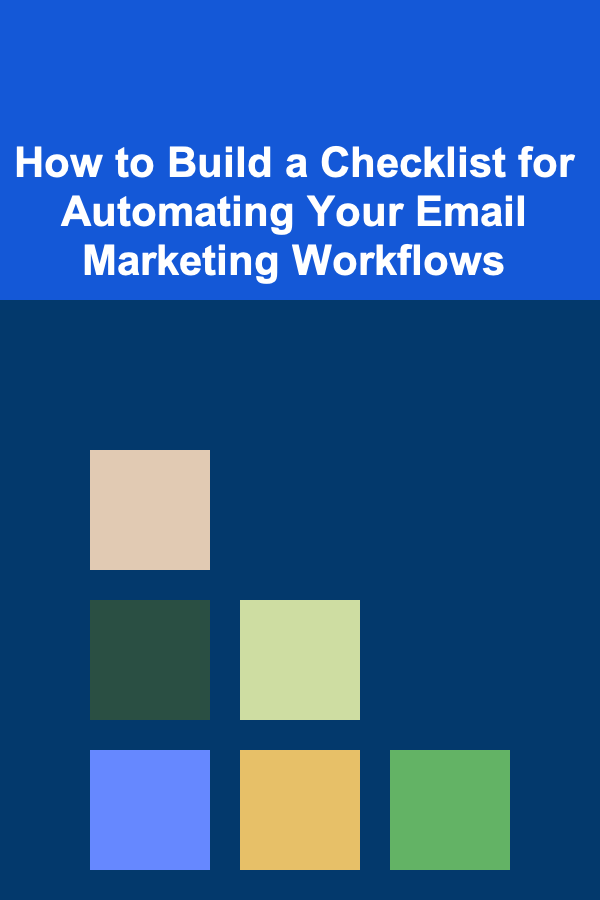
How to Build a Checklist for Automating Your Email Marketing Workflows
ebook include PDF & Audio bundle (Micro Guide)
$12.99$8.99
Limited Time Offer! Order within the next:

Email marketing remains one of the most powerful tools in a marketer's arsenal. It provides direct access to your audience, delivering personalized messages that can drive sales, engagement, and brand loyalty. However, as your business grows, manually managing email campaigns becomes inefficient and time-consuming. This is where automation can be a game changer.
Building a checklist for automating your email marketing workflows is a smart way to streamline processes, improve efficiency, and ensure you don't miss important steps. A well-structured checklist helps you stay organized and guarantees that your automated campaigns perform at their best.
In this actionable guide, we will walk through the process of creating an email marketing automation checklist that is tailored to your business needs. By the end, you'll have a solid plan for automating your email marketing workflows and optimizing their effectiveness.
Define Your Goals
Before automating anything, it's important to establish what you want to achieve with your email marketing campaigns. Defining your goals will guide your automation strategy, helping you create workflows that align with your overall marketing objectives.
Key Goals to Consider:
- Increase sales: Do you want to nurture leads and drive conversions?
- Engagement: Are you trying to boost open rates, clicks, or overall engagement with your audience?
- Customer retention: Do you want to improve customer loyalty and reduce churn?
- Brand awareness: Are you aiming to grow your email list or introduce new products/services?
Clearly defining your goals will make it easier to tailor your email automation flows and measure their success over time.
Segment Your Audience
Segmentation is one of the most important steps in email marketing automation. When you segment your audience, you ensure that your messages are relevant to each subscriber. This leads to better engagement and higher conversion rates.
Segmentation Criteria:
- Demographics: Age, gender, location, etc.
- Behavioral data: Past purchases, email engagement, website activity.
- Lead status: Are they a new subscriber, a returning customer, or a high-value lead?
- Engagement levels: How often does the person open or click on your emails?
By creating different segments, you can personalize the email content based on the recipient's characteristics and behavior. This increases the chances of your emails being well-received.
Choose the Right Email Automation Platform
An effective email marketing automation platform is the backbone of your workflow. The platform you choose should offer the right features to meet your business needs and be easy to integrate with other tools you use.
Key Features to Look for:
- User-friendly interface: The platform should be intuitive and easy to navigate.
- Segmentation options: Ensure that it offers robust segmentation capabilities.
- Automation triggers: Look for platforms that allow you to set up triggers based on customer behavior (e.g., abandoned cart emails, welcome emails, etc.).
- Personalization: Choose a platform that allows dynamic content insertion (e.g., recipient's name, recommended products).
- A/B testing: The ability to test different subject lines, email copy, and design.
- Analytics: Make sure it provides detailed reports on email performance, such as open rates, click rates, conversions, etc.
Some popular email marketing automation platforms include Mailchimp, ActiveCampaign, HubSpot, and ConvertKit. Choose one based on your specific needs and budget.
Plan Your Email Campaigns and Workflows
Now that you have your goals and tools in place, it's time to design your automated email campaigns. A well-planned workflow ensures that your emails reach the right people at the right time, without you having to manually send them.
Steps for Designing Your Workflows:
-
Identify key touchpoints: Think about where your audience interacts with your brand. These touchpoints are critical moments when you can engage them with an email. For example:
- Welcome emails for new subscribers
- Abandoned cart reminders for e-commerce stores
- Birthday emails to make customers feel special
- Post-purchase follow-ups asking for feedback or offering product recommendations
-
Choose your automation triggers: A trigger is an event that prompts your email to be sent. Some common triggers include:
- Signing up for a newsletter
- Making a purchase
- Engaging with an email or landing page
- Specific dates or anniversaries
-
Set up your email sequences: Depending on the goal of the campaign, create a series of emails that will automatically follow each other. For instance:
- A welcome sequence for new subscribers (Email 1: Introduction, Email 2: How to use your product/service, Email 3: Special offer)
- An abandoned cart sequence (Email 1: Reminder with product image, Email 2: Offer a discount, Email 3: Final reminder)
-
Create varied email content: Tailor your messages to each stage of the customer journey. For instance:
- New subscribers might get a discount code or a welcome gift.
- Engaged customers might receive content or offers based on their past behavior.
- Loyal customers might be sent exclusive deals or early product access.
Write Compelling Email Copy
No matter how sophisticated your automation is, if your email copy isn't compelling, your campaigns won't succeed. High-quality copy is essential to keeping subscribers engaged and driving them toward action.
Key Tips for Writing Effective Email Copy:
- Personalize the subject line: Personalization improves open rates. Use the recipient's name or other data to create subject lines that grab attention.
- Keep it concise: People skim emails. Use short paragraphs, bullet points, and clear headings to make your email easy to read.
- Provide value: Focus on how your products/services solve a problem or benefit your subscribers. Include special offers, discounts, or helpful content.
- Use clear calls to action (CTAs): Ensure each email has a clear action for the reader to take (e.g., "Shop Now," "Learn More," "Claim Your Discount").
- Optimize for mobile: Most people read emails on their smartphones, so make sure your emails are mobile-friendly.
Test and Optimize Your Campaigns
Once your automation workflows are live, it's important to continuously test and optimize them. Small changes can have a big impact on performance, so running regular tests will help you fine-tune your campaigns.
Ways to Test and Optimize:
- A/B testing: Test different subject lines, CTAs, email designs, and sending times to see which combinations yield the best results.
- Review analytics: Look at key metrics such as open rates, click-through rates, and conversions. Use this data to adjust your strategy.
- Segment further: As your email list grows, you might want to segment further. For example, you could create segments based on purchase frequency or average order value.
- Refine email content: Based on feedback or performance, refine the language, visuals, and offers in your emails. Regularly updating your content will keep it fresh and engaging.
Automate Follow-ups and Drip Campaigns
Drip campaigns are a series of automated emails sent over time to nurture leads and convert them into paying customers. By automating follow-ups and drip campaigns, you ensure consistent communication with your audience, even when you're busy with other tasks.
Types of Follow-ups:
- Lead nurturing emails: Send a series of emails to educate, build trust, and push leads further down the sales funnel.
- Post-purchase emails: After a customer makes a purchase, send them follow-up emails asking for feedback, offering cross-sells or upsells, or encouraging referrals.
- Re-engagement emails: For inactive subscribers, set up an email flow designed to re-engage them with a special offer or update.
Monitor and Improve Deliverability
Even with the best strategy in place, your emails won't generate results if they never land in your recipients' inboxes. Ensuring good deliverability is crucial for any email marketing campaign.
Tips to Improve Deliverability:
- Clean your email list regularly: Remove inactive or invalid email addresses.
- Monitor your sender reputation: Avoid sending too many emails in a short time or using spammy words, which can hurt your reputation.
- Authenticate your domain: Set up SPF, DKIM, and DMARC records to prove your emails are legitimate and reduce the chance of them being marked as spam.
Conclusion
Automating your email marketing workflows can save time, improve efficiency, and increase the effectiveness of your campaigns. By following this checklist, you can ensure that your email automation is set up strategically and consistently delivers value to your subscribers. From defining your goals and segmenting your audience to optimizing your emails and continuously testing, each step plays an important role in building a successful automated email marketing system. The right tools, a solid plan, and regular optimizations will keep your workflows running smoothly and help your business grow.
Reading More From Our Other Websites
- [Biking 101] The Ultimate Guide to Road Bikes: Features, Benefits, and Tips
- [Organization Tip 101] The Best Wallpaper Removal Steamers for DIY Home Improvement
- [Beachcombing Tip 101] Best Strategies for Spotting Offshore Jelly Jelly Remnants After Storms
- [Biking 101] Bike Grips vs. Handlebar Tape: Which Is Better for Your Ride?
- [Gardening 101] The Ultimate Guide to Garden Pest Control for Healthy Plants
- [Home Cleaning 101] How to Remove Stubborn Carpet Stains Without Chemicals
- [Home Staging 101] How to Stage a Home with Neutral Decor for Maximum Appeal
- [Personal Care Tips 101] How to Create Soft Waves Using Hair Mousse
- [Home Renovating 101] How to Create a Productive Home Office Renovation on a Budget
- [Personal Investment 101] How to Monitor Your Investment Portfolio Regularly

How to Create a Cozy Atmosphere for an Indoor Winter Party
Read More
How to Ensure Your Rental Property Meets Safety Standards
Read More
How to Make the Most of Tiny Spaces with Smart Storage Ideas
Read More
How to Renovate Your Home on a Budget
Read More
Top Tips for Saving Money on Baby Diapers and Wipes Without Compromising Quality
Read More
How to Install a Ceiling Fan: A Comprehensive Guide
Read MoreOther Products

How to Create a Cozy Atmosphere for an Indoor Winter Party
Read More
How to Ensure Your Rental Property Meets Safety Standards
Read More
How to Make the Most of Tiny Spaces with Smart Storage Ideas
Read More
How to Renovate Your Home on a Budget
Read More
Top Tips for Saving Money on Baby Diapers and Wipes Without Compromising Quality
Read More